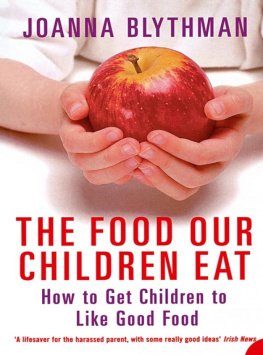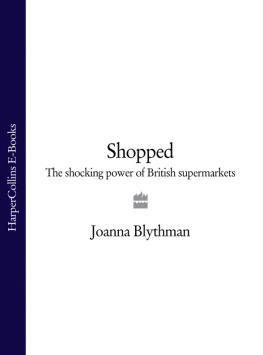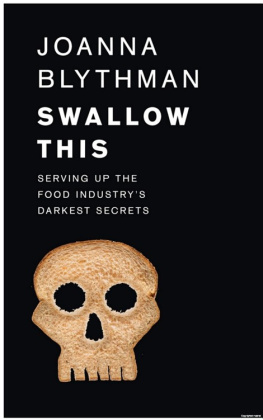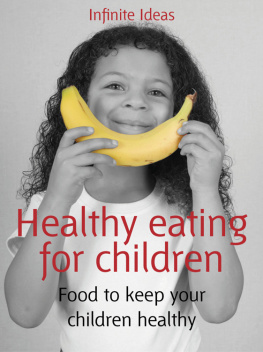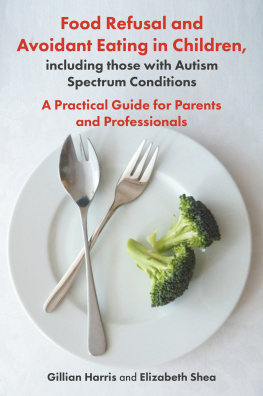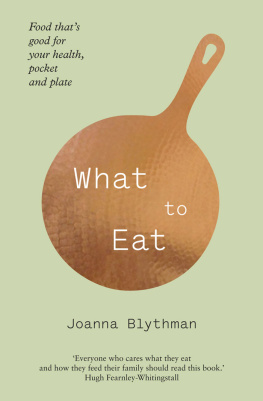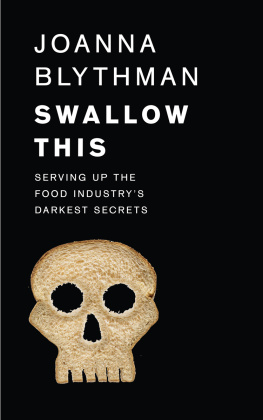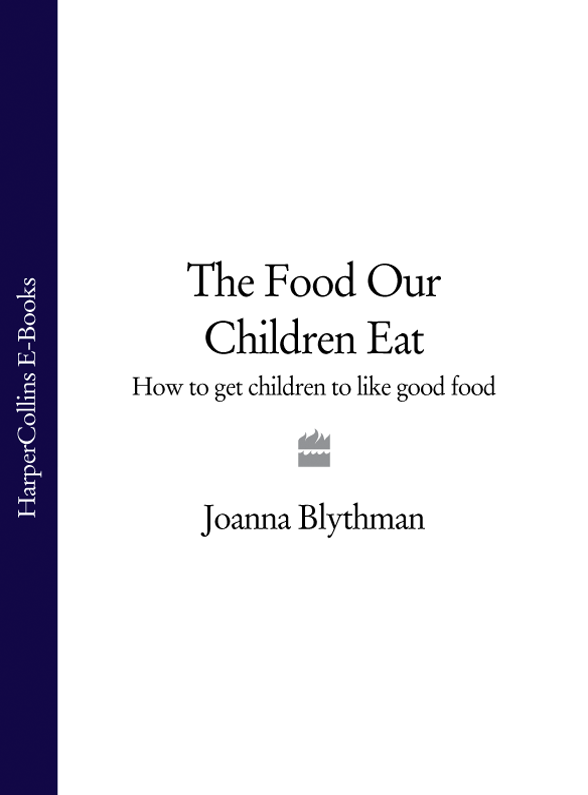
THE FOOD OUR
CHILDREN EAT
How to Get Children to Like Good Food
Joanna Blythman

CONTENTS
This is a book for people who want their children to become adults with wide-ranging food tastes, adults who select a good diet for themselves and find pleasure in the process of eating.
Achieving such an outcome ought to be a straightforward matter, but these days children who fit this bill are something of an endangered species. Children no longer eat what adults eat. We now live in a world that assumes children must be catered for separately, from a repertoire of special childrens foods designed to please their distinctive palate.
In the new millennium, perhaps sociologists and social historians will look back on the second half of the twentieth century and point to the emergence of this separate diet as a curious phenomenon. When you stop to think about it, its a huge watershed. For centuries children all over the world have been brought up to eat what their parents ate.
Traditionally, childrens food has always been inextricably linked with adult diet, right from day one. Children were breastfed even if that meant finding a wet nurse.
Graduating on to more complex foods, they were fed ground-down, pulverised versions of what the extended family was eating. As soon as they had teeth and had become more independent, they ate whatever was produced in the kitchen in whatever form it emerged.
Now in many industrialised countries, and in the UK in particular, its more likely that children are tucking into a restricted number of specifically childrens foods. We are all too familiar with them. The working title junk fits them as well as any other. But if we wanted to analyse that loaded term a little further, we might describe it as consisting of a small selection of highly processed, long-life foods many technological interventions removed from their raw-food roots heavily loaded with fat, sugar and salt.
Enter the modern child and a typical food day. This might start with a bowl of highly refined cereal stuck together with sugar in one form or another, followed by a sweet drink and a packet of crisps for morning snack. Chips and custard might be the most popular canteen choice at lunchtime, or a protein and fat-based, vegetable-free sandwich in the lunch box, accompanied by sweets, a token apple (if youre lucky) and often yet another packet of crisps. In the starving after-school interval, biscuits and more crisps fill the gap until an early childrens teatime, when out come the frozen Kievs, fish fingers, pizzas and burgers, destined to be scoffed with chips and copious amounts of ketchup and washed down by something sweet and fizzy. For pudding, theres the sickly-sweet kiddie yogurt with its lovable cartoon characters and child-friendly synthetic flavours. Not surprisingly, by bedtime theyre hungry again and its time for supper. That packet of cereal beckons once more, as do the biscuits.
The consequences of this change in our attitude towards child nutrition are so enormous that they are hard to grasp. We are embarked on an experiment with our childrens health that is unprecedented. This is a radical departure from the tried and tested way of nourishing children that societies have adopted since history began.
You dont have to be a paediatrician to figure out that this sort of eating defies the laws of nutrition. Nearly every item has been processed out of its natural form. It is top-heavy on ingredients we know cause health problems long-term and notoriously short on those that keep the human body healthy: whole, unprocessed plant foods, especially fruit and vegetables. So we are living through a strange irony. Instead of being given the best food available, as they ought to be, children are being given the worst.
It is going to take time for the impact of this major change in eating patterns to show through but initial indications are not good. Worrying tales have emerged from the US, where doctors have been shocked by the premature furring up of arteries that has inadvertently come to light when children have been admitted to hospital as road casualties.
Teachers complain that their pupils concentration span is not what it should be because they are going from one quick sugary snack to another and simply dont have the stamina that a long, slow release of nutrients from a balanced diet would give them. According to the World Health Organisation, The prevalence of overweight and obesity is increasing worldwide at an alarming rate Moreover, as the problem appears to be increasing rapidly in children as well as adults, the truth health consequences may only become fully apparent in the distant future.
Knowing how far this modern childrens diet is from any concept of good food, let alone healthy eating, an outside observer might assume that it is the prerogative of a poor and disadvantaged underclass that cant afford to feed its children properly. But junk food is the great leveller. These days children from affluent backgrounds often eat as badly as their less privileged counterparts. The nations youth, it seems, is united in its attachment to junk.
Many parents recognise that they are not feeding their children the way they themselves were fed when young and they worry about this. But our anxieties are soothed by the overwhelming cynicism that surrounds the whole subject of feeding children. The fact that most children in the U K eat extremely badly has become institutionalised. Though new parents set out with good intentions, pureing wholesome foods and vowing to be different, theres a prevalent feeling that its only a matter of time till children graduate on to the modern crisps-and-cola, burgers-and-turkey-nugget repertoire. After all, they encounter it everywhere at school, at friends houses, at the corner shop, on television.
The pressure on children to eat junk is so strong and so widespread that many parents simply throw in the towel. Why fight the inevitable, especially when no one else seems to be bothered? And theres succour to be had from the feeling of safety in numbers, too. If all those freezer cabinets are full of pre-fried, re-formed bits of cheap animal protein targeted at children, surely they cant be too bad? If the neighbourhood crche recommends crisps as a morning snack because fruit makes too much mess, who are we to stick out our necks and say differently? So many children live on this typical childrens diet that surely it must be the norm?
Thus we live in hope that sooner or later, as though by magic, our offspring will be transformed miraculously into sensible adults with wide-ranging, sophisticated food tastes. We fondly imagine that burger-and-biscuit-addicted Kevin or Holly will turn into a marvellous eighteen-year-old who adores spinach salad, or stir-fried squid, aubergine and anchovies.
If you find those rationalisations comforting, then you may not want to read on. This book is for people who have the gut reaction that, however ubiquitous and common it might have become, the typical childrens diet is unacceptable. First, because it drastically limits childrens food horizons and therefore their ability to get pleasure from the delicious diversity of foods available, not to mention the sociable rituals that surround eating. Second, because it deviates so much from any notion of good nutrition that it stores up problems for their long-term health.
The core is that we need separate and different childrens food about as badly as we need a fatal illness. Instead, we should abandon the whole concept and reintegrate children into mainstream eating.
Next page
